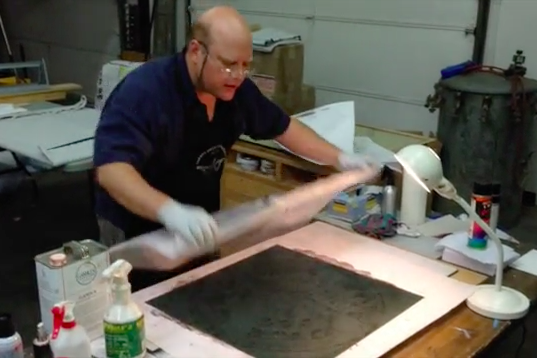
Part 7: Cleaning the Plate
Watch this Video:
|
Previous Page:
|
Video Transcription Index | Watch All Printmaking Videos
|
The following is a text transcription of Part 7 of our short, 7-part video tutorial series on photogravure intaglio printmaking using Intaglio Editions polymer photogravure plates.
Printmaking instructor Don Messec of Making Art Safely in Santa Fe originally suggested this technique for cleaning these plates to us, and it has proven wonderfully successful in maintaining the structure of the plate's matrix. While the higher resolution aquatint screen and nylon plates used by Intaglio Editions does create richer and greater tonal range with the plates (depending on the color and consistency of the inks), it does make the plates more sensitive to scratching.
This doesn't mean they may not be cleaned somewhat aggressively as demonstrated in the video! So long as you ensure the environment is reasonably free of metallic shavings, glass fragments, or hard sharp particles, you can go to town and get them perfectly clean without worrying about scratching them. If you do, we can offer replacement plates for larger editions at a lower rate if purchased ahead of time. we also offer test plates at a reduced rate allowing the printmaker to experiment before ordering a large plate, thus saving cost on having to replace multiple larger plates!
Video Transcription: Part 7 - Cleaning the Plate
Demonstration of cleaning polymer photogravure plates
Jon Lybrook, Intaglio Editions - March 2014
"Hi, my name is Jon and I'm with Intaglio Editions, and I'm going to show you how to clean your Intaglio Editions plates.
We use the Toyobo KM-73 plate. It's made of nylon and it is a little more sensitive than standard polymer plates because we use a high-resolution aquatint screen.
So, we recommend cleaning it with Soy Solv-2. This is a soy-based solvent and it's available on the Internet...that's usually where I buy it in quantity.
We've already inked and printed this plate and so I'm going to apply Soy Solv and just spray it on, and I'm kind of using my hand as a funnel to block the spray so it doesn't get everywhere, and then with a clean gloved hand I'm just massaging the Soy Solv into the plate to help pick up some of the ink, and we're going to do this twice, first time picks up the majority of the ink, second time we get a little bit more, and then we're going to take it over to the press where we will then run it through on a clean newsprint and that helps pull up all the ink.
This is a big plate so it's going to take a little bit longer to clean... so then I blot it with...it can be relatively dirty newsprint, doesn't have to be immaculate for this stage in the cleaning process...you can see a lot of the ink coming up.
Soy Solv is much gentler on the plate than a lot of standard solvents. But for a final wipe we like to use Gamsol, which is a odorless mineral spirit, and it's a lot kinder on the environment and on your lungs, it's a little more expensive too but you're worth it.
So now that we've got a lot of the ink off the plate we're going to take it over the press...and then I like to take four sheets of clean pristine newsprint to sop it up, and we've found four is just the right number so that it doesn't leaks through on to the blanket...the press. And I don't use the same amount of pressure as I might with printing plates, so a little bit less pressure is adequate for cleaning and pulling ink off the plate. So we want to run it through once.
And now I'm going to reorder the clean newsprint so that we've got another clean sheet of the newsprint to pull up even more of the ink and then I'm just taking this nasty one and putting it on top...I'm just reordering it, kind of working this pattern for the solvent.
Okay, so at this point we've only put Soy Solv on the plate and it's pretty clean but I'm going to do another cleaning...final wipe with mineral spirits, and again, I'll be using the Gamsol, and for this I'm going to use a clean glove...one clean glove...and there's Gamsol in this container here and I'm just kind of saturate...not totally saturating the plate but making sure it's covered and that there's no dry areas on the plate...and this just kind of wicks up the last little bit of ink that's in the plate... and this will make it so the plate can be preserved and stored and used again months later or possibly even years later. So then I just take the same side that I did the last run of the Soy Solv with and put it on top...there isn't much Soy Solv in there so it'll pick up that last bit of mineral spirit and this will be...And there you have it.
The last thing I like to do with the plate once it's...once it's gone through these steps is I just give it a quick rag wipe with a clean...plain old rag ideally, and that picks up even the last remaining bit, and the other thing I like to do is wipe the edges of the plate so any residual mineral spirits or Soy Solv isn't in the plate, so if you happen to be printing the next day it won't remain there and leaks into your...the first print you print that day.
And as for as storage, I typically will wrap it in newsprint and tape it shut and store it flat in flat file or some cool dry place.
And that's it, that's how to clean your KM-73 Plate from Intaglio Editions. Thanks!"
|


